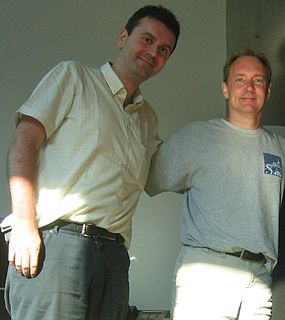Hyper Search is a method of link analysis for search engines. It was created by Italian researcher Massimo Marchiori. [1]

Hypertext is text displayed on a computer display or other electronic devices with references (hyperlinks) to other text that the reader can immediately access. Hypertext documents are interconnected by hyperlinks, which are typically activated by a mouse click, keypress set, or screen touch. Apart from text, the term "hypertext" is also sometimes used to describe tables, images, and other presentational content formats with integrated hyperlinks. Hypertext is one of the key underlying concepts of the World Wide Web, where Web pages are often written in the Hypertext Markup Language (HTML). As implemented on the Web, hypertext enables the easy-to-use publication of information over the Internet.

A Web crawler, sometimes called a spider or spiderbot and often shortened to crawler, is an Internet bot that systematically browses the World Wide Web and that is typically operated by search engines for the purpose of Web indexing.
Spamdexing is the deliberate manipulation of search engine indexes. It involves a number of methods, such as link building and repeating unrelated phrases, to manipulate the relevance or prominence of resources indexed, in a manner inconsistent with the purpose of the indexing system.

Search engine optimization (SEO) is the process of improving the quality and quantity of website traffic to a website or a web page from search engines. SEO targets unpaid traffic rather than direct traffic or paid traffic. Unpaid traffic may originate from different kinds of searches, including image search, video search, academic search, news search, and industry-specific vertical search engines.
Distributed web crawling is a distributed computing technique whereby Internet search engines employ many computers to index the Internet via web crawling. Such systems may allow for users to voluntarily offer their own computing and bandwidth resources towards crawling web pages. By spreading the load of these tasks across many computers, costs that would otherwise be spent on maintaining large computing clusters are avoided.
The deep web, invisible web, or hidden web are parts of the World Wide Web whose contents are not indexed by standard web search-engines. This is in contrast to the "surface web", which is accessible to anyone using the Internet. Computer-scientist Michael K. Bergman is credited with coining the term in 2001 as a search-indexing term.
ALIWEB is considered the first Web search engine, as its predecessors were either built with different purposes or were only indexers.

Tantek Çelik is a Turkish-American computer scientist, currently the Web standards lead at Mozilla Corporation. Çelik was previously the chief technologist at Technorati. He worked on microformats and is one of the principal editors of several Cascading Style Sheets (CSS) specifications. He is author of HTML5 Now: A Step-by-Step Video Tutorial for Getting Started Today (ISBN 978-0-321-71991-1).

Alan Emtage is a Bajan-Canadian computer scientist who conceived and implemented the first version of Archie, a pre-Web Internet search engine for locating material in public FTP archives. It is widely considered the world's first Internet search engine.
The World Wide Web Worm (WWWW) was one of the earliest search engines for the World Wide Web (WWW). It is claimed by some to be the first search engine, though it was not released until March 1994, by which time a number of other search engines had been made publicly available. It was developed in September 1993 by Oliver McBryan at the University of Colorado as a research project.

A search engine is a software system designed to carry out web searches. They search the World Wide Web in a systematic way for particular information specified in a textual web search query. The search results are generally presented in a line of results, often referred to as search engine results pages (SERPs). The information may be a mix of links to web pages, images, videos, infographics, articles, research papers, and other types of files. Some search engines also mine data available in databases or open directories. Unlike web directories and social bookmarking sites, which are maintained by human editors, search engines also maintain real-time information by running an algorithm on a web crawler. Any internet-based content that can't be indexed and searched by a web search engine falls under the category of deep web.

The World Wide Web is a global information medium which users can access via computers connected to the Internet. The term is often mistakenly used as a synonym for the Internet, but the Web is a service that operates over the Internet, just as email and Usenet do. The history of the Internet and the history of hypertext date back significantly farther than that of the World Wide Web.

Massimo Marchiori is an Italian mathematician and computer scientist.
A focused crawler is a web crawler that collects Web pages that satisfy some specific property, by carefully prioritizing the crawl frontier and managing the hyperlink exploration process. Some predicates may be based on simple, deterministic and surface properties. For example, a crawler's mission may be to crawl pages from only the .jp domain. Other predicates may be softer or comparative, e.g., "crawl pages about baseball", or "crawl pages with large PageRank". An important page property pertains to topics, leading to 'topical crawlers'. For example, a topical crawler may be deployed to collect pages about solar power, swine flu, or even more abstract concepts like controversy while minimizing resources spent fetching pages on other topics. Crawl frontier management may not be the only device used by focused crawlers; they may use a Web directory, a Web text index, backlinks, or any other Web artifact.

JumpStation was the first WWW search engine that behaved, and appeared to the user, the way current web search engines do. It started indexing on 12 December 1993 and was announced on the Mosaic "What's New" webpage on 21 December 1993. It was hosted at the University of Stirling in Scotland.

Learning to rank or machine-learned ranking (MLR) is the application of machine learning, typically supervised, semi-supervised or reinforcement learning, in the construction of ranking models for information retrieval systems. Training data consists of lists of items with some partial order specified between items in each list. This order is typically induced by giving a numerical or ordinal score or a binary judgment for each item. The goal of constructing the ranking model is to rank new, unseen lists in a similar way to rankings in the training data.

PageRank (PR) is an algorithm used by Google Search to rank web pages in their search engine results. It is named after both the term "web page" and co-founder Larry Page. PageRank is a way of measuring the importance of website pages. According to Google:
PageRank works by counting the number and quality of links to a page to determine a rough estimate of how important the website is. The underlying assumption is that more important websites are likely to receive more links from other websites.
Volunia was a web search engine created by Massimo Marchiori. It was launched in beta only for registered power users on February 6, 2012 and went live on June 14, 2012. Volunia, dubbed as "the search engine of the future", was speculated to be based on Hyper Search technology. On June 8, 2012 Marchiori announced with an open letter that he had been excluded from his project: six days later, on June 14, 2012 the site went live, but it ceased to operate in February 2014.
Martijn Koster is a Dutch software engineer noted for his pioneering work on Internet searching.
In web analytics, a session, or visit is a unit of measurement of a user's actions taken within a period of time or with regard to completion of a task. Sessions are also used in operational analytics and provision of user-specific recommendations. There are two primary methods used to define a session: time-oriented approaches based on continuity in user activity and navigation-based approaches based on continuity in a chain of requested pages.